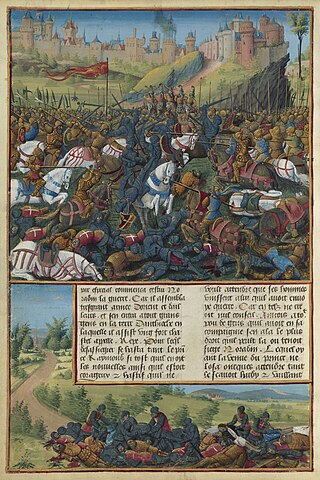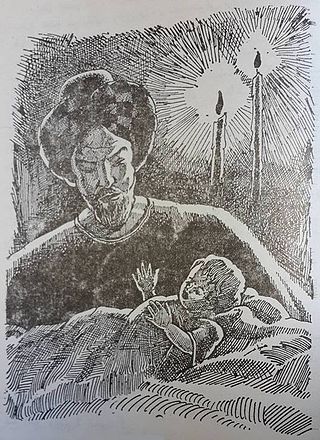
The Second Crusade (1145–1149) was the second major crusade launched from Europe. The Second Crusade was started in response to the fall of the County of Edessa in 1144 to the forces of Zengi. The county had been founded during the First Crusade (1096–1099) by King Baldwin I of Jerusalem in 1098. While it was the first Crusader state to be founded, it was also the first to fall.

The Zengiddynasty was a Muslim dynasty of Oghuz Turkic origin, which ruled parts of the Levant and Upper Mesopotamia on behalf of the Seljuk Empire and eventually seized control of Egypt in 1169. In 1174 the Zengid state extended from Tripoli to Hamadan and from Yemen to Sivas. The dynasty was founded by Imad ad-Din Zengi.

Imad al-Din Zengi, also romanized as Zangi, Zengui, Zenki, and Zanki, was a Turkoman atabeg, who ruled Mosul, Aleppo, Hama, and, later, Edessa. He was the namesake of the Zengid dynasty.

Nūr al-Dīn Maḥmūd Zengī, commonly known as Nur ad-Din, was a member of the Zengid dynasty, which ruled the Syrian province (Shām) of the Seljuk Empire. He reigned from 1146 to 1174. He is regarded as an important figure of the Second Crusade.

Joscelin II of Edessa was the fourth and last ruling count of Edessa. He was son of his predecessor Joscelin I of Edessa and Beatrice, daughter of Constantine I of Armenia.
Majd ad-Dīn Usāma ibn Murshid ibn ʿAlī ibn Munqidh al-Kināni al-Kalbī or Ibn Munqidh was a medieval Arab Muslim poet, author, faris (knight), and diplomat from the Banu Munqidh dynasty of Shaizar in northern Syria. His life coincided with the rise of several medieval Muslim dynasties, the arrival of the First Crusade, and the establishment of the crusader states.

The Battle of Inab, also called Battle of Ard al-Hâtim or Fons Muratus, was fought on 29 June 1149, during the Second Crusade. The Zengid army of Atabeg Nur ad-Din Zangi destroyed the combined army of Prince Raymond of Poitiers and the Assassins of Ali ibn-Wafa. The Principality of Antioch was subsequently pillaged and reduced in size as its eastern border was pushed west.
Abu Said Aq Sunqur al-Hajib was the Seljuk governor of Aleppo under Sultan Malik Shah I. He was considered the de facto ruler of most of Syria from 1087. He was beheaded in 1094 following accusations of treason by Tutush I, the ruler of Damascus.

Saif ad-Din Ghazi I was the Emir of Mosul from 1146 to 1149, who fought in the Second Crusade. He was the eldest son of Imad al-Din Zengi of Mosul, and the elder brother of Nur ad-Din.
As-Salih Ismaʿil al-Malik (1163–1181) was an emir of Damascus and emir of Aleppo in 1174, the son of Nur ad-Din.

The siege of Edessa took place from November 28 to December 24, 1144, resulting in the fall of the capital of the crusader County of Edessa to Zengi, the atabeg of Mosul and Aleppo. This event was the catalyst for the Second Crusade.
Najm ad-Din Ilghazi ibn Artuq was the Turkoman Artukid ruler of Mardin from 1107 to 1122. He was born into the Oghuz tribe of Döğer.
Mu'in ad-Din Unur al-Atabeki; was a mid-12th century ruler of Damascus from 1140 to 1149. He was a Turkman slave of Burid emirs.

al-Malik al-Afdal Najm al-Dīn Ayyūb ibn Shādhi ibn Marwān was a Kurdish soldier and politician from Dvin, and the father of Saladin. He is the eponymous ancestor of the Ayyubid dynasty.

Sayf al-Din Ghazi (II) ibn Mawdud was a Zangid Emir of Mosul, the nephew of Nur ad-Din Zengi.

Prince Akram Shammaa Al Zengi was a Prince of Al Zengid Dynasty. He was a politician, lawyer and real estate investor. He was a descendant of the Zengid Dynasty that ruled Syria and parts of Iraq between 1127 and 1234
Alp Arslan ibn Mahmud was ruler of Mosul from 1127-1146. As son of Mahmud II, he was appointed governor of Mosul in 1127 with Zengi as his atabeg. While governor in name only, Alp aspired to replace Ghiyath ad-Din Mas’ud as sultan upon his death. In 1145, Alp conspired to kill Zengi’s deputy Naşīr al-Dīn Jaqar and take control of Mosul. His co-conspirator was likely Farrukh-Shāh ibn Mahmūd, who provided assurances that the army would support Alp. Naşīr was killed by Alp, Farrukh or their followers, and his head thrown for effect towards Zengi’s forces. Qadi Taj al-Din Yahya ibn Shahrazuri encouraged Alp to take control of the citadel at Mosul, escorting him there, where he and his followers were arrested by Zengi loyalists. Zengi dispatched his commander Zain-ad-Din ‘Ali Küchük to control the situation. The conspirators were executed and Alp was kept close to Zengi until his death in 1146. Alp Arslan was then replaced by Zengi’s son Saif ad-Din Ghazi I who had him imprisoned.
Gümüshtekin, also known as Gumushtekin, was an eunuch who held high offices in the Zengids' empire. Nur ad-Din, atabeg of Aleppo, appointed him to be his lieutenant in Mosul in Iraq. After Nur ad-Din died in 1174, Gümüshtekin assumed the guardianship for Nur ad-Din's underage son, as-Salih Ismail al-Malik and took his ward from Damascus to Aleppo. He made an alliance with as-Salih's cousin Sayf al-Din Ghazi II of Mosul against Ibn al-Muqaddam who had taken control of Damascus. Ibn al-Muqaddam sought assistance from the Ayubbid ruler of Egypt, Saladin, and surrendered the city to him. As-Salih granted Harem in iqta' to him.
Husam al-Din Timurtash was an Artuqid emir of Mardin (1122–1154) and ruler of Aleppo (1124–1125).